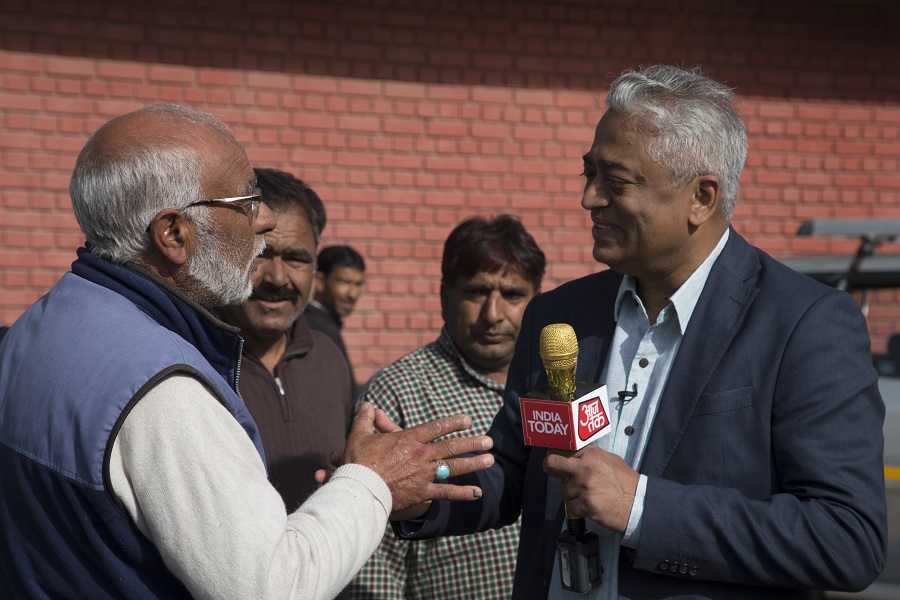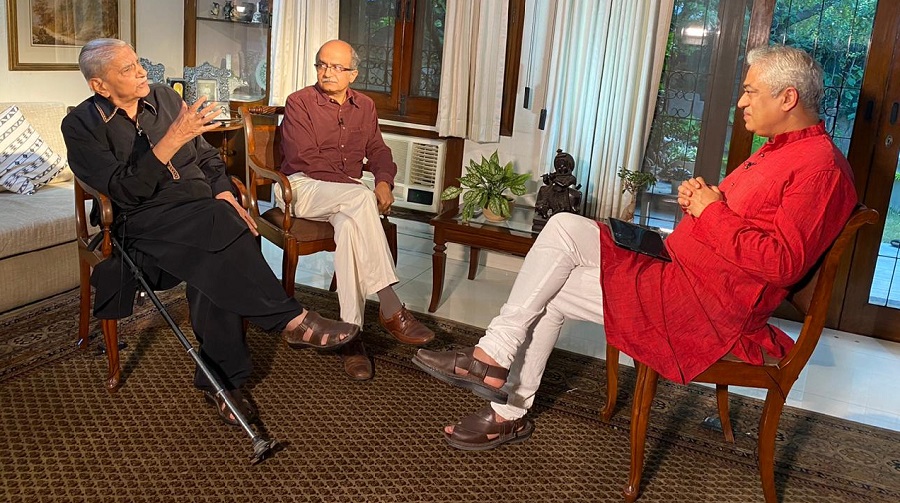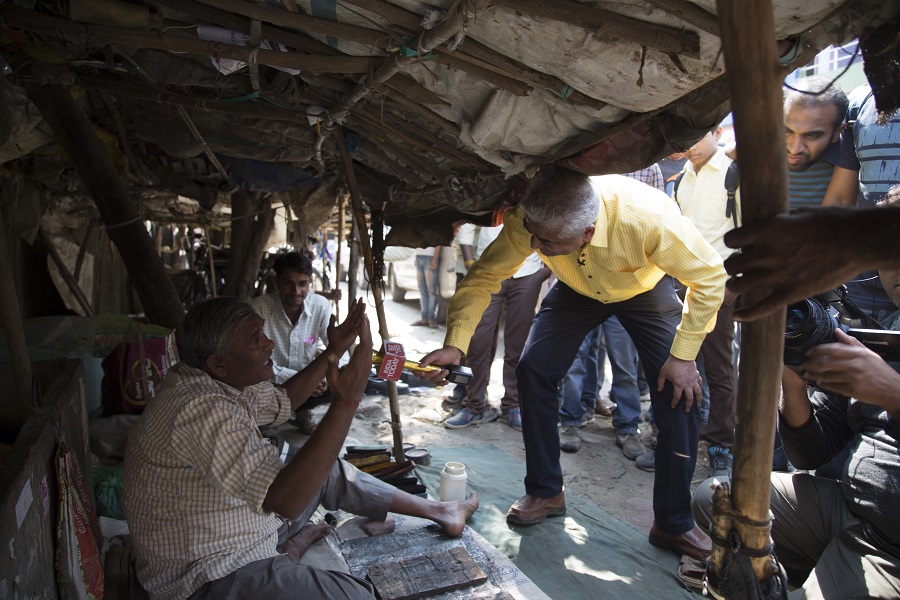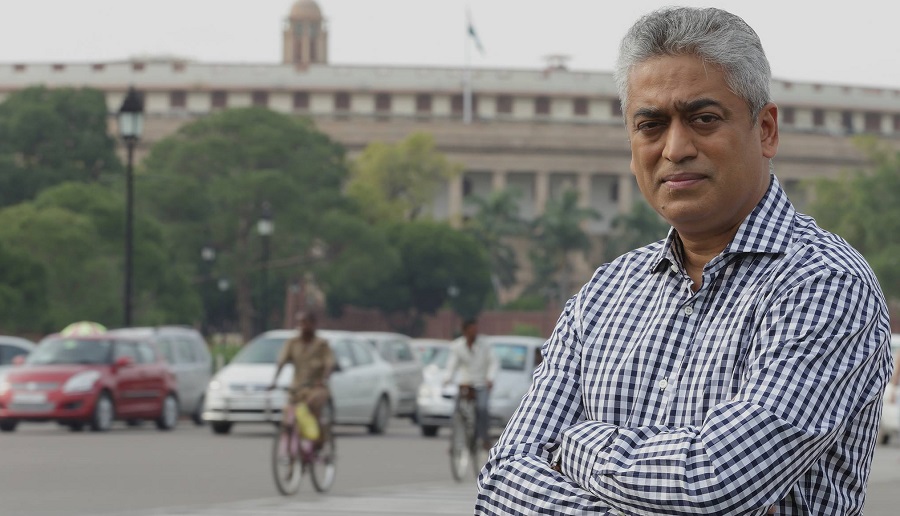Celebrity anchor Rajdeep Sardesai knew from the word go that he had a mega-scoop on his hands when he landed a marathon interview with Rhea Chakraborty and that it would bring out the trolls in strength. But he was astonished by the welter of hate mail that landed on his online doorstep after the broadcast. That astonishment now has turned to dismay and fury in the face of an unending tide of abuse.
“I have been targeted. People are saying, ‘You must have taken money.’ This is a hyper-polarised, hyper-angry society that’s out to hound people,” Sardesai says heatedly.
Sardesai’s so livid about what’s going on around him that he feels a divide growing between himself and the profession that he loves. “I feel distanced from the medium I have been a part of. The newsroom has always been a home away from home for me. Now they’re giving space to this lynch mob mentality. This is not why we became journalists.”
But he reserves his greatest anger for social media which he calls a “digital Frankenstein that rips everything apart”. He adds: “Rhea is a story playing out in an era of the social media Frankenstein. TV has allowed itself to become a part of it.”
For Sardesai, the Chakraborty saga began with a tweet he made suggesting trial by media of Chakraborty was unfair. That led to a series of calls and finally, a mad scramble to Delhi airport after a caller said the interview would have to be done the very same evening. Sardesai caught the 7.49pm SpiceJet flight to Mumbai to Delhi and finally kicked off the interview after midnight. Chakraborty looked at the fat docket Sardesai had taken along and remarked, “You seem to have a lot of questions.” But she insisted she was ready to answer anything he threw at her. Says Sardesai: “I was impressed by someone saying, ‘Feel free to ask whatever you want’.”
And that’s exactly what he did. Over the next two hours, Sardesai threw all manner of allegations that have been aired since Sushant Singh Rajput died. He asked about Rajput’s old girlfriend Ankita Lokhande and about whether Chakraborty was part of a drugs cartel and whether she took drugs herself.
It speaks volumes that Sardesai who has been a familiar face on Indian television screens for more than two decades is almost an odd man out in an era of multiple channels and hyper-competitive ratings wars. He’s still striving – often against the odds – for neutral journalism and telling a story without slanting one way or another. Says Sardesai: “How do I deal with the noise around me? You just do what you have been doing. News is not a Big Boss show. You try to create a space.”
Old-fashioned journalism or not, Sardesai who’s 55 certainly crams a lot into his working day. He hosts daily TV shows – though he stresses that he gets Sundays off because he’s a consulting editor at India Today TV and not a hands-on administrator. In between, he writes a weekly newspaper column and during the last six years, has turned out three books – two political volumes on the 2014 and 2019 elections and the third a book on cricket, the great love of his life. He even puts aside half-an-hour each day to ensure that his 8.9 million Twitter followers are kept informed and entertained. Till not so long ago, he did two half-hour Twitter sessions daily but has now taken the social networking site off his mobile. “You can’t run away from social media,” he says, adding, “my resolution now is to only spend half-an-hour on it.”
What’s his secret of success? “I am active and energetic. There’s lots of time. You just have to manage it.” Time management means sitting down, usually on Wednesdays, and writing his newspaper column between 7am and 9am. His latest book, ‘2019 How Modi Won India,’ was written from June and September last year and he managed to set aside two-three hours daily for it.
Sardesai, who’s married to another prominent journalist Sagarika Ghose with whom he has a son and a daughter, confesses that after all these years what keeps him going is a huge love for news. It was a trait that manifested itself early when, as a precocious pre-teen he headed to the American Center to watch the Jimmy Carter-Gerald Ford presidential elections in 1976. “At the age of 11 I had a love for current affairs,” he says.

Rajdeep Sardesai on the road in Srinagar, talking to a taxi driver. Surinder Nagar
Mind you, it could have been totally different. As a youngster, Sardesai was also totally obsessed by cricket and dreamt of following in his father, Dilip Sardesai’s illustrious footsteps. This wasn’t an idle dream because he captained the Bombay schools team, played first class cricket at Oxford and made it to the India Under-19 trial camp. So,, it wasn’t far-fetched to think of a Test career.
Why he changed his mind must probably be attributed to a host of reasons, but Sardesai reckons that a pivotal moment came when he was at Oxford and playing for the Oxford-Cambridge team against Pakistan. It wasn’t a successful day at the crease and he got out for a mere two runs after facing Pakistani spinner Abdul Qadir. As he was walking off the field, one Pakistani fielder muttered at him. “You’re an Indian and you can’t play spin.” That, he says, was the last straw on the cricket field for him. He says, with considerable modesty: “My father had talent. I didn’t have talent.”
Sardesai has found himself at several such crossroads during his life. At Oxford, he trained to be a lawyer. But after returning to India, he decided he didn’t want to don a black gown and dedicate his life to the hurly-burly of the Indian courts. Instead, he interned at Mumbai’s punchy Afternoon Despatch & Courier. “I loved the newspaper. Print gives me a high. The smell of the newspaper was a high.”
That helped him move to the Times of India where he rose meteorically and became news editor by 26. It was a great time to be at the heart of events both in Maximum City and outside. One important assignment was covering the Rath Yatra in Gujarat where he happened to meet a young pracharak Narendra Modi.
Most crucially, he led the reporting team during the Mumbai riots and he considers that one of the most fulfilling achievements of his career. Suddenly, the south Mumbai youngster who had led a relatively insulated life got to know every inch of the city. Also, the newspaper had such clout in the city at that time that everything they did was noticed. “Whatever you reported made an impact,” he says. He and his team did a book on the riots but he says it didn’t make an impact without famous names to back it. “It was a seriously good book but nobody read it,” he says sadly.

Rajdeep Sardesai interviewing Shanti Bhushan and Prashant Bhushan. Telegraph picture
The next fork in the road came when he was working at The Telegraph and received an offer to jump into the brave new world of news television. He was sad to leave print but doesn’t think for a moment that he made a mistake. “I would have loved to have been the editor of a daily newspaper. But I can’t regret television after all it has given me.”
The climb to fame became unstoppable from the moment he appeared on our TV screens. In 2002, he was the man on the frontlines of the Gujarat riots, often going on air as the stones and brickbats were still flying in the background. For Indian viewers, it was a nerve-shattering experience because it was the first time that riots had unfolded before their eyes and in their homes.
There’ve been ups and downs over the last two decades. Sardesai reckons that NDTV was a time of “cutting-edge journalism”, but that the years when he was the chief of CNN-IBN TV18 were “the most professionally rewarding”. He says: “Everyone had written us off. We built a team and one year we got every Ramnath Goenka award.” In a farewell letter to the CNN-IBN team in 2014, he put it even more colourfully, saying: “I still remember when we decided to set up an English news channel: we had one chair and a table, and no one gave us a hope in hell. I recall an advertising executive watching our pitch and asking why we were even attempting a new news channel.”
He threw in a PS at the conclusion of the letter, indicating he wasn’t always the easiest boss to work with: “Am sorry if I would occasionally call at 3am in the morning. Blame it on being a news junkie.”
Sardesai then spent a few months writing his book on the 2014 elections and then moved to India Today TV as a consulting editor. But by then he could see the world of television news changing radically. Social media was turning the atmosphere more poisonous and the plethora of news channels meant impossibly brutal ratings wars.
Says Sardesai: “This never used to happen. The viewer was not this angry ranting person. I am only the journalist. Don’t make me the story.” To some extent, he also blames senior politicians for fuelling the fire, asking: “If political leaders start following abusive handles, what is left?”
He also defends himself against accusations that he’s too soft on the people he interviews. Last week, he did an interview with activist lawyer Prashant Bhushan and his father Shanti Bhushan, who was a former law minister. Again, this resulted in an avalanche of angry trolling. Says Sardesai: “Why should Prashant Bhushan not have a voice?” He replies to the charges that he isn’t tough enough on his subjects, saying: “People ask why aren’t you asking tough questions? I am having a conversation.”
Interviewing Rhea Chakraborty also gave him an additional bonus of getting to see his mother in Mumbai after a six-month gap.
Sardesai says he’s grateful to India Today for standing by him when he’s been attacked. He concedes, though, that at times the strain of it all almost gets too much to handle. But he has always had readymade fallbacks, watching old cricket videos on YouTube, listening to his all-time favourite, Kishore Kumar and following what he calls, “a disciplined life”.

Rajdeep Sardesai in Bhopal talking to a cobbler Surinder Nagar
“Sometimes, you retreat into Kishore Kumar. I am deeply troubled. To retain sanity I don’t watch news. I do more reading and writing,” he says, adding: “2020 was to have been a year of relaxation. I thought I would learn cooking and do more reading and writing.”
Instead, everyone’s world has gone topsy-turvy and it’s been a very different year from what Sardesai or anyone else could have conceived. He clocks in for work by joining the noon editorial conference from home. From then, it’s a helter-skelter news day that goes on till late night with an afternoon nap and walk thrown in. Sardesai reckons that TV news has missed the opportunity to tackle in-depth stories that would throw light on crucial subjects. “This is the time to be dissecting the economy,” he says. “It is important to realise that news should be in the public interest. That concept has got severely diluted.”
What’s next if the world of news loses its allure? Sardesai says he’s always wanted to own a mango and cashew farm in Goa. But he laughs that off for now, saying: “I won’t think too far ahead.”
Sardesai thinks back to his days in print when asked what keeps him going. At the Times of India, the person in the next cabin was the legendary cartoonist R. K. Laxman. Sardesai remembers asking Laxman how he kept going, turning out one cartoon after another. Laxman’s philosophical reply was: “Every day is a new day.”
Sardesai’s world view is almost certainly very different, so what keeps him going? After all these years the answer – despite the trolls – is still is very clear: “It’s daily news that gives me an adrenaline rush,” he says. He’s still driven by that “madness and a passion for journalism” he wrote about in his goodbye IBN letter six years ago.











